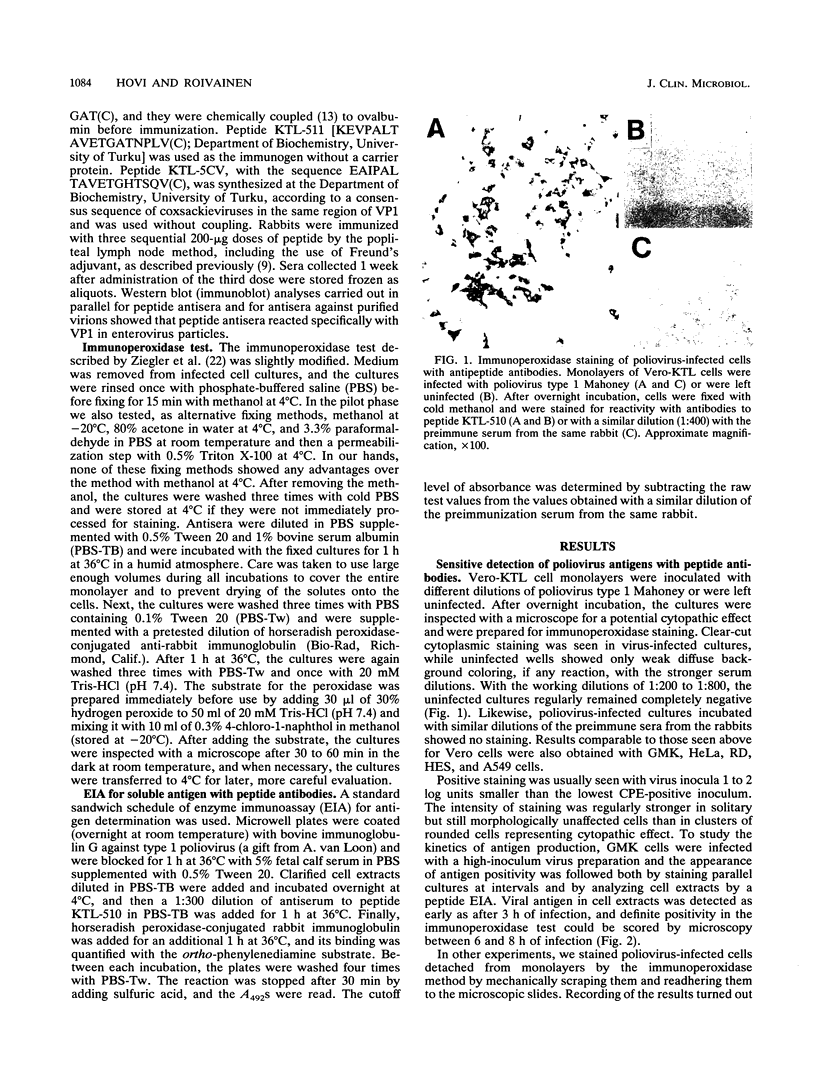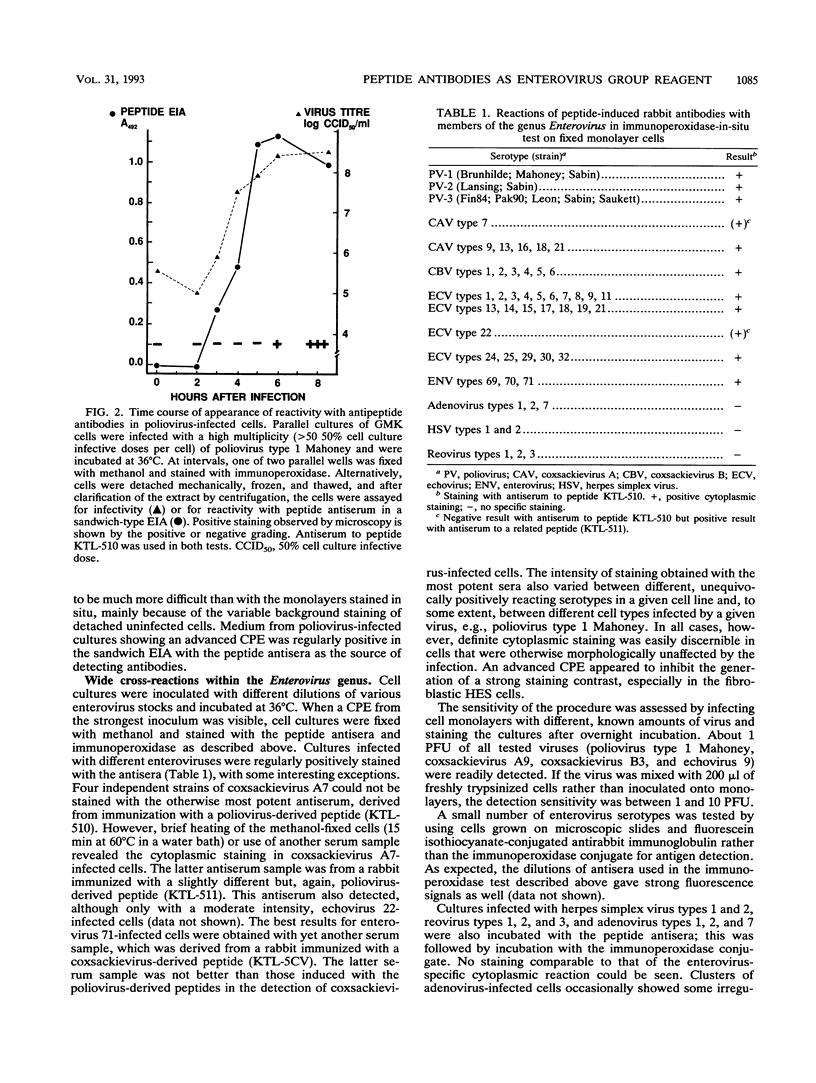Abstract
Rabbits were immunized with synthetic peptides derived from an immunodominant region of the VP1 capsid protein of enteroviruses. This region shows a high degree of homology among all sequenced members of the genus. Peptide-induced antisera were used for immunoperoxidase staining of cell cultures infected with 41 different serotypes of enterovirus. Specific cytoplasmic staining was readily seen in all but two cases. Echovirus type 22 was previously known to differ genetically from the rest of the enteroviruses, and hence, a negative result was expected. Surprisingly, one of the tested serum samples reacted with echovirus 22-infected cells. Coxsackievirus A7-infected cells could be reliably stained with only one of the tested serum samples. For the remaining 39 serotypes, scattered infected cells resulting from 1 to 2 days of incubation with diluted inocula were easily scored as positive before the cytopathic effect became visible. The same antibodies were also used in a sandwich-type enzyme immunoassay to demonstrate poliovirus antigens in cell extracts as early as 3 h after a high-multiplicity infection. These antibodies are candidates for enterovirus group reagents, being potentially useful in both the laboratory diagnosis of enterovirus infections and research on enterovirus-host interactions.
Full text
PDF




Images in this article
Selected References
These references are in PubMed. This may not be the complete list of references from this article.
- Chang K. H., Auvinen P., Hyypiä T., Stanway G. The nucleotide sequence of coxsackievirus A9; implications for receptor binding and enterovirus classification. J Gen Virol. 1989 Dec;70(Pt 12):3269–3280. doi: 10.1099/0022-1317-70-12-3269. [DOI] [PubMed] [Google Scholar]
- Chapman N. M., Tracy S., Gauntt C. J., Fortmueller U. Molecular detection and identification of enteroviruses using enzymatic amplification and nucleic acid hybridization. J Clin Microbiol. 1990 May;28(5):843–850. doi: 10.1128/jcm.28.5.843-850.1990. [DOI] [PMC free article] [PubMed] [Google Scholar]
- Cova L., Kopecka H., Aymard M., Girard M. Use of cRNA probes for the detection of enteroviruses by molecular hybridization. J Med Virol. 1988 Jan;24(1):11–18. doi: 10.1002/jmv.1890240103. [DOI] [PubMed] [Google Scholar]
- Geysen H. M., Meloen R. H., Barteling S. J. Use of peptide synthesis to probe viral antigens for epitopes to a resolution of a single amino acid. Proc Natl Acad Sci U S A. 1984 Jul;81(13):3998–4002. doi: 10.1073/pnas.81.13.3998. [DOI] [PMC free article] [PubMed] [Google Scholar]
- Hyypiä T., Auvinen P., Maaronen M. Polymerase chain reaction for human picornaviruses. J Gen Virol. 1989 Dec;70(Pt 12):3261–3268. doi: 10.1099/0022-1317-70-12-3261. [DOI] [PubMed] [Google Scholar]
- Hyypiä T., Horsnell C., Maaronen M., Khan M., Kalkkinen N., Auvinen P., Kinnunen L., Stanway G. A distinct picornavirus group identified by sequence analysis. Proc Natl Acad Sci U S A. 1992 Sep 15;89(18):8847–8851. doi: 10.1073/pnas.89.18.8847. [DOI] [PMC free article] [PubMed] [Google Scholar]
- Hyypiä T., Stålhandske P., Vainionpä R., Pettersson U. Detection of enteroviruses by spot hybridization. J Clin Microbiol. 1984 Mar;19(3):436–438. doi: 10.1128/jcm.19.3.436-438.1984. [DOI] [PMC free article] [PubMed] [Google Scholar]
- Melnick J. L. Poliomyelitis: eradication in sight. Epidemiol Infect. 1992 Feb;108(1):1–18. doi: 10.1017/s0950268800049451. [DOI] [PMC free article] [PubMed] [Google Scholar]
- Närvänen A., Korkolainen M., Kontio S., Suni J., Turtianen S., Partanen P., Soos J., Vaheri A., Huhtala M. L. Highly immunoreactive antigenic site in a hydrophobic domain of HIV-1 gp41 which remains undetectable with conventional immunochemical methods. AIDS. 1988 Apr;2(2):119–123. doi: 10.1097/00002030-198804000-00008. [DOI] [PubMed] [Google Scholar]
- Olive D. M., Al-Mufti S., Al-Mulla W., Khan M. A., Pasca A., Stanway G., Al-Nakib W. Detection and differentiation of picornaviruses in clinical samples following genomic amplification. J Gen Virol. 1990 Sep;71(Pt 9):2141–2147. doi: 10.1099/0022-1317-71-9-2141. [DOI] [PubMed] [Google Scholar]
- Roivainen M., Närvänen A., Korkolainen M., Huhtala M. L., Hovi T. Antigenic regions of poliovirus type 3/Sabin capsid proteins recognized by human sera in the peptide scanning technique. Virology. 1991 Jan;180(1):99–107. doi: 10.1016/0042-6822(91)90013-2. [DOI] [PubMed] [Google Scholar]
- Rotbart H. A., Levin M. J., Villarreal L. P. Use of subgenomic poliovirus DNA hybridization probes to detect the major subgroups of enteroviruses. J Clin Microbiol. 1984 Dec;20(6):1105–1108. doi: 10.1128/jcm.20.6.1105-1108.1984. [DOI] [PMC free article] [PubMed] [Google Scholar]
- Ryan M. D., Jenkins O., Hughes P. J., Brown A., Knowles N. J., Booth D., Minor P. D., Almond J. W. The complete nucleotide sequence of enterovirus type 70: relationships with other members of the picornaviridae. J Gen Virol. 1990 Oct;71(Pt 10):2291–2299. doi: 10.1099/0022-1317-71-10-2291. [DOI] [PubMed] [Google Scholar]
- Toyoda H., Kohara M., Kataoka Y., Suganuma T., Omata T., Imura N., Nomoto A. Complete nucleotide sequences of all three poliovirus serotype genomes. Implication for genetic relationship, gene function and antigenic determinants. J Mol Biol. 1984 Apr 25;174(4):561–585. doi: 10.1016/0022-2836(84)90084-6. [DOI] [PubMed] [Google Scholar]
- Yousef G. E., Brown I. N., Mowbray J. F. Derivation and biochemical characterization of an enterovirus group-specific monoclonal antibody. Intervirology. 1987;28(3):163–170. doi: 10.1159/000150012. [DOI] [PubMed] [Google Scholar]
- Ziegler T., Waris M., Rautiainen M., Arstila P. Herpes simplex virus detection by macroscopic reading after overnight incubation and immunoperoxidase staining. J Clin Microbiol. 1988 Oct;26(10):2013–2017. doi: 10.1128/jcm.26.10.2013-2017.1988. [DOI] [PMC free article] [PubMed] [Google Scholar]



